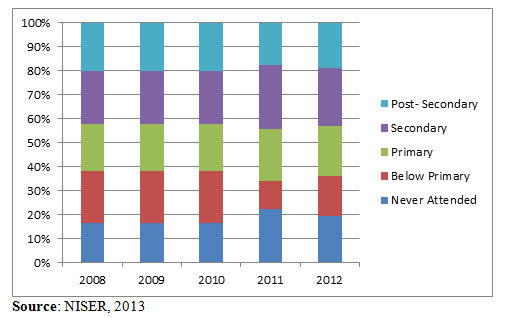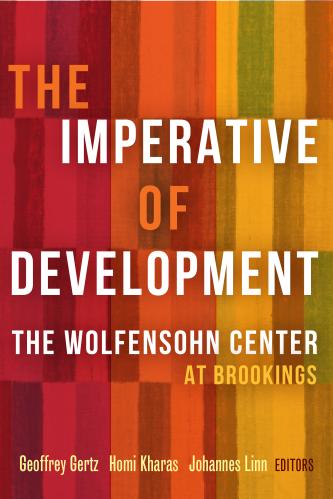The State of Youth Unemployment in Nigeria
Nigeria’s population is said to have reached about 167 million people in 2012 (National Bureau of Statistics). The National Population Commission (NPoC, 2013) states about half of the population is made up of youth, defined as individuals between 15 and 34 years of age. Unfortunately, as the youth population grows, so does the unemployment rate. In fact, unemployed youth numbered about 11.1 million in 2012. Here we explore a number of trends in youth unemployment in Nigeria and discuss various government programs attempting to address the problem.
First, in terms of age, younger youth struggle even more to find jobs: At least two-thirds of unemployed youth are between 15 and 24 years of age. And, in terms of gender, available statistics show that a majority of unemployed youth are female. As shown in Table 1, women accounted for more than 50 percent of unemployed youth between 2008 and 2012.
Analysis of youth unemployment by geographical/settlement location (rural and urban areas) indicates that youth unemployment is mostly in rural areas and rapidly growing: From 2010 to 2011, the share of unemployed youth in rural areas increased from 47.59 percent to 59.95 percent. The population of unemployed youth in rural areas rose from 2.9 million in 2008 to about 5.9 million in 2012.
Table 1: National Youth Unemployment Figures by Gender and Geography, 2008-2012.

Relatedly, in terms of education, from 2008-2012, over half of unemployed youth did not have an education past primary school (see Figure 1). This particular group has consistently accounted for over 50 percent of all unemployed youth. However, graduates of tertiary institutions also seem to be badly hit by unemployment too—making up about 20 percent of youth unemployment and often remaining unemployed for upward of five years after graduation (NISER, 2013).
Figure 1: National Youth Unemployment Figures (15-34 years) by Education, 2008-2012

Several factors may be blamed for the prevalence of youth unemployment in Nigeria. There is a high population growth rate—3.5 percent per annum—which accompanies an already large national population of over 167 million people. In addition, deficient school curricula and poor teacher training have contributed to the failure of educational institutions to provide their students the appropriate skills to make them employable. Since schools in rural areas are generally more deficient in infrastructure, teaching facilities and teacher quality than schools in urban areas, this may help account for the high growth in rural unemployed youth. In fact, some experts suggest that the major jump in rural youth unemployment in 2011 (see Table 1) could be due to the mass failure in national examinations conducted among final-year secondary school students in 2010, which made many of them unemployable in 2011.
In addition to these supply factors, there is a lack of vibrant industries to absorb competent graduates. This obstacle was in part caused by an infrastructural deficit and a debilitating structural adjustment program (SAP) implemented by Nigeria in the 1980s, which led to the closure of many industries and from which the country is yet to fully recover. It is also well-known that the youth unemployment situation has been aggravated by flawed and inconsistent public policies on employment.
Another reason might be that policymakers have had to confront inadequate information and data that can form the basis of effective planning. As reported in other studies (Asaju et al., 2014 and Iwayemi, 2014), employment data are very hard to obtain, even from statutory institutions and agencies established for gathering socio-economic data. Where unemployment registers exist at all, they are limited to urban areas, and, in fact, not all those searching for employment attempt to register. In the absence of such data, policymakers tend to rely on cross-sectional household surveys, which are often inconsistent and full of errors. This lack of data makes it difficult for policymakers to understand the nature of the employment challenge and make informed decisions on how to support young people in the labor market. The scarcity of data on informal employment and entrepreneurship in particular is a major obstacle, given the importance of this sector for youth employment.
Public Policies That Have Worked Best
Ascertaining policies that have worked in addressing unemployment in Nigeria is rather difficult in light of the incredibly high and rising unemployment rate—and at least around 1.8 million youth are entering the labor market every year (Falusi, 2014). Since it is unclear to what extent any given intervention may have reduced the youth unemployment rate in aggregate, it may be more helpful to think of effective policies as those which have delivered on their stated objectives. The sustainability of a program could also be considered an indicator of success.
Different programs have been introduced by various administrations over time to address youth unemployment, which has been an issue of significant public concern since the days of SAP. In fact, youth unemployment became the focus of the social policy of the military government that ruled Nigeria for much of its years as an independent nation. The initial reaction of the government was to draft unemployed youth to public programs such as Operation Feed the Nation (OFN) and the Directorate of Food, Road and Rural Infrastructure (DIFRRI), which provided immediate and direct jobs to participants interested in agriculture.
More coordinated and planned measures later followed, and these are classified into three categories: labor demand, labor supply and labor market interventions. Labor demand strategy focused on creating jobs immediately through public works or creating certain jobs in the private sector aimed at promoting entrepreneurship and skills enhancement. Labor supply strategy dealt with the training and education of prospective job seekers. The labor market intervention strategy focused on improving the labor market and matching demand and supply interrelationships.
However, with the transition to civilian rule in 1999, successive civilian administrations— including the current leadership—have tried to refocus unemployment programs, discontinuing many of the old programs, restructuring some of them and creating new ones. It should be noted that as a federation, public policy on employment has been addressed at the three levels of government—federal, state and local—and that this new emphasis on unemployment has made youth the primary constituency of concern. Consequently, certain institutional arrangements and agencies have been established to promote employment among youth. Three of the current and most prominent programs include the Subsidy Reinvestment and Empowerment Programme (SURE-P), the Youth Enterprise With Innovation in Nigeria (YOU-WIN) and the Osun State Youth Employment Scheme (O’YES), among others.
The SURE-P was introduced in February 2012 and focuses on management and investment of federal government savings derived from proceeds accruing from the partial removal of the subsidy on petroleum products. The SURE-P is the flagship of recent efforts to provide job opportunities to graduates of tertiary institutions. It is more or less a whole range of activities and programmatic schemes, including the Graduate Internship Scheme (GIS), Community Services Scheme (CSS), Vocational Training Scheme (VTS), and Community Services, Women and Youth Empowerment (CSWYE), among others.
One of the more successful schemes of the SURE-P is the GIS, which offers unemployed graduates the opportunity to undergo a one-year internship in firms, banks, ministries, government departments and agencies, as well as in small and medium enterprises (SMEs), relevant to beneficiaries’ disciplines. The purpose of GIS is to help beneficiaries acquire the appropriate skills and practical knowledge that will make them more suitable for the job market. About 50,000 graduates were selected for the first phase of the scheme out of some 85,000 applicants. Even though around 2000 firms expressed interest in hosting graduates, only 293 firms were approved.
This indicates that most of the firms that wished to participate in the program were unable to meet the rigorous selection criteria. To be selected, a firm had to be registered with the Corporate Affairs Commission, show evidence of Value Added Tax registration and possess a Tax Clearance Certificate. In addition, the firm had to submit training and mentoring plans for each of their interns. The firms were further assessed on the basis of their years of business experience and location. A final criterion was that the firm had to pass a verification exercise, which involved confirmation of information regarding its mentoring capabilities and the number of interns it could host.
Companies that met these criteria and were selected to participate enjoyed a host of benefits, including tax rebates, free labor from their interns (the government paid a monthly stipend of N18,000, approximately US$110, to interns) and the opportunity to claim that they are fulfilling some aspects of their corporate social responsibility (CSR) to the community in which they operate. Testimony from participants shows overwhelming acceptance of the scheme, saying it enhanced their job skills, provided them with practical knowledge, improved their chances of employment by the firms that provided their training, and by other private companies, government institutions, or helped them establish their own businesses through an initial capital provided by the government. The number of participants for the 2014/2015 period of the program will be increased to 100,000.
The YOU-WIN program was designed to create job opportunities specifically, again, for graduates of tertiary institutions that elect to go into business as entrepreneurs. Simply put, participants are required to develop and execute their own business ideas that will provide jobs for themselves and other unemployed youths who may or not be graduates. By 2015, the program is expected to have provided 40,000 to 50,000 new jobs, encouraged expansion, specialization and job spinoffs of existing businesses, and enabled young entrepreneurs to have a broad professional and business network (NPC, 2013).
At the state level, the government established various forms of employment-creating programs. The most prominent one is the Osun Youth Empowerment Scheme (OÝES) established by the state of Osun. The scheme provides a series of employment opportunities for participants as traffic controllers, sanitation and environmental officials, security personnel, and other works and services. The World Bank has singled out the OYES scheme for its success in promoting youth employment in Nigeria and has recommended the scheme for replication by the federal and other state governments.
Why Have Some Programs Been Unsuccessful?
Public policies directed at addressing youth unemployment have faced different challenges including finance, the absence of good administration and implementation, inconsistent policies, unimpressive responses from would-be trainees, and unqualified resource personnel handling the training programs. As stated above, programs that were expected to be successful but did not meet those expectations were those created in the 1980s and have not drastically improved in spite of modifications over the years. For example, the National Accelerated Poverty Reduction Program (NAPEP) was too big for its meager budgetary allocation over the years. Many of the available funds for the program went to overhead and administrative costs in offices spread over the entire country, limiting its impact. Similarly, the National Directorate of Employment (NDE) had no openings of its own to engage unemployed youth, providing only vocational training to young school leavers. There have been insufficient funds to provide start-off capital for the youth who complete their training.
While many programs have targeted creating opportunities for youth employment, the outcomes have been greatly limited by a host of factors, including:
Training is not supplemented with loans and not targeted appropriately: According to a recent survey by the Nigerian Institute of Social and Economic Research (NISER), youth unemployment programs have concentrated more on training than on other activities that actually provide openings for immediate employment in white-collar jobs or jobs in the small- and medium-scale industries (NISER, 2013). This strategy has not yielded the desired results because the training is often not accompanied by soft loans, which graduating trainees could use as start-up capital in order to facilitate their quick integration into the labor market. Targeting has also presented a challenge. Often, all categories of unemployed youth are lumped together as if they are homogeneous (in terms of education, skill, capabilities, etc.) when, in fact, there ought to be distinctions on the basis of education, experience, and willingness to learn. The lumping together of graduates of primary school with those coming out of secondary schools and/or tertiary institutions makes training not only ineffective but also less impactful.
Weak management, complex structures and inadequate funding hinder success: When you run a multiplicity of programs at the same time under a weak management structure and practice, with inadequate funding, and with several layers of authorities that sometimes bicker among themselves, there is the risk of not being focused and effective. The process becomes complex in the absence of monitoring and coordination of planned activities. Indeed, the responsibility for youth employment policy is split among a wide range of ministries and agencies, often operating in isolation and competition with each other. In the absence of a coherent strategic approach, resources are likely to be misapplied. In addition, public funding is often insufficient and erratic and, indeed, not released fully.
The problem is largely structural and therefore needs structural solutions: The initiatives listed earlier simply bring a select group of youth into employment, but are grossly inadequate to accommodate the army of unemployed youth. Besides, these programs are conceived with short-term gains in mind, and a little consideration of long-term perspective that may change the dynamics of unemployment substantially. The structural changes needed involve taking a comprehensive approach to employment issues in general. This could be done in a way that not only targets youth, but which also looks at educational, training and labor market issues so that dynamic and progressive policy interventions are initiated to address all issues comprehensively.
Demand-side factors need to be considered: A final consideration is to ask whether indeed a policy stance actually addresses factors that limit the demand for labor. Recently, public policy has encouraged youth to undertake entrepreneurship, which can make them create employment for themselves and also become employers of labor. However, in the long-run, the industrial sector must also expand to create opportunities for youth. Industrial expansion must be based on available local resources in agriculture and solid mineral exploitation as well as value chain activities in those two sectors. The development of infrastructure, particularly electricity, will provide the necessary boost to any meaningful approach towards expanding industrial production space and creating employment for millions of job seekers, especially Nigerian youth. For example, the petroleum industry that has dominated Nigeria’s external trade since the 1970s failed to provide employment opportunities for the people, given the technical knowhow required in the industry and so has not been helpful in solving the problem of youth unemployment. What is required (and which is now being considered) is to open up the petroleum downstream industries and train young people to provide services that are required at this level—activities such as welding, pipeline maintenance, security and other services.
Alas, these public policy programs have had a mixed impact on youth unemployment. While a number of intervention programs did address critical needs, others failed to address the needs of youth as a specific group. The management and administrative oversight of the programs has been weak and sometimes problematic, perhaps because of multiple authorities (federal, state and local government agencies) managing the programs. Some have been known to expend more money than is necessary or at least failed to justify the amount of public money devoted to such programs.
Note
: Tunji Akande is a professor of agricultural economics at the Nigerian Institute of Social and Economic Research (NISER). NISER is one of the Brookings Africa Growth Initiative’s six local think tank partners based in Africa. The piece is based on NISER (2013) as acknowledged under the references. This blog reflects the views of the author only and does not reflect the views of the Africa Growth Initiative.
REFERENCES
Asaju, K, S. Arome and S. Anyio (2014): The rising rate of unemployment in Nigeria the Socio-economic and political implications, Global Business and Economic Research Journal,3(2): 12-32. Available online at http:www.journal.globejournal.org
Falusi, A. O. (2014): Employment Generation for Poverty Reduction in Nigeria: Issues for Consideration. Presented at the 21st Celebration of the Development Policy Centre in memory of Professor Ojetunji Aboyade, 9th September.
Iwayemi, Akin (2013): Youth unemployment in Nigeria – Challenges and Way Forward. Paper presented at the World Bank Regional Workshop on Youth. Abuja. July 23-24.
National Planning Commission, NPC (2013): Mid-Term Report of the Transformation Agenda, May 2011 – May 2013: Taking Stock, Moving Forward. Abuja.
National Population Commission, NPoC (2013): Nigeria’s unemployment rate rises to 23.9% —NPC, Punch Newspaper, October 13, 2013
NISER (2004): Nigeria Urban Youth Employment and Empowerment Project (NUYEEP) – Youth Background Study, in collaboration with the World Bank
NISER (2013): Analysis and Design of Safety Nets and Capacity Empowerment Program for unemployed Youth in Nigeria
World Bank (2003): Youth Employment Policy in Developing and Transition Countries –prevention as well as Cure. Washington, DC: World Bank.
World Bank (2008): Youth Employment in Africa. Africa Development Indicators 2008/9. Washington, DC: World Bank.
The Brookings Institution is committed to quality, independence, and impact.
We are supported by a diverse array of funders. In line with our values and policies, each Brookings publication represents the sole views of its author(s).



Commentary
Youth Unemployment in Nigeria: A Situation Analysis
September 23, 2014